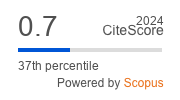Manifestation and response of Laryngopharygeal reflux to treatment in Kurdistan -IRAQ
Keywords:
Laryngopharyngeal reflux, Reflux laryngitis, GERDAbstract
BACKGROUND: In 1972 complete description of the
inflammation of posterior third of the vocal cords was
done, with barium swallow confirming Gastro
Esophageal Disease [CRED] & subsequent successful
symptomatic treatment with antacid. The possible
association between GERD & chronic laryngitis was
initially known as acid laryngitis .2
*from the Department of ENT, Hawlear Medical College, Hawlear university. Department of ENT, Rezgary Teaching Hospital, Erbil.
Correspondence to :
Dr.Said Mustafa Said
Corespondence Address to : Dr.Said Mustafa Said _ E- mail: Email [email protected] Mob. 07504563829
Recived at : 15 th Dec 2009 Accepted at : 3ed Nov 2010
OBJECTIVE: To record the common presentation
symptoms of laryngopharyngeal reflux LPR in
Kurdistan- Iraq. To study the significance of fibro optic
laryngoscope in diagnosis and improvement of
laryngopharyngeal reflux [LPR] and to evaluate the
effect of medical therapy on these nonspecific
symptoms and Laryngoscopic finding.
METHODS: A prospective study was conducted over
a two year period at Rizgary teaching hospital,
Kurdistan/lraq; on 132 patients who presented
primarily with Laryngopharyngeal symptoms .They
were evaluated using special questionnaire for
recording these symptoms: persistent chronic cough,
globus sensation, throat clearing, voice change,
regurgitation, heartburn, symptoms of peptic ulcer
disease, and any other non specific respiratory
symptom. These symptom and Laryngoscopic findings
pre and post anti-reflux therapy were recorded.
Esophagogastro - duodenoscopy findings were also
recorded but only on presentation.
RESULTS: A total of 132 patients were evaluated over
a two year period .Respiratory symptoms at
presentation were persistent irritative cough [92%],
itchy throat [85%], globus pharynges [83%], and
cricopharngeal spasm [57%]. Endoscope findings
revealed gastroduodenitis in 5%, non specific gastritis
in 9%, duodenal ulcer in 2%, and normal findings in
62.7%, while Laryngoscopic finding were mainly
posterior commissure injection 82%, vocal cord edema
74%, laryngeal erythema 77% and subglottic edema
24%. Patients were treated medically with antacids, H2
antagonists, proton pump inhibitors and were followed
up and reexamined by laryngoscope; all data about
improvement in symptom and in the laryngeal sign by
Laryngoscopic findings were collected following antireflux therapy and showed significant improvement in
both ,all were analyzed in special figures and tables.
CONCLUSION: Reflux laryngitis and LPR should be
a differential diagnosis in patient with pharyngeal and
laryngeal symptoms not associated with upper
respiratory disease in the presence or absence of GERD
or peptic ulcer symptom, dyspepsia, regurgitation. The
management should be multidisciplinary.
Laryngoscopic finding were of value in the diagnosis of
the changes in laryngeal mucosa pre and post medical
treatment by Proton Pump Inhibitors empirical therapy













